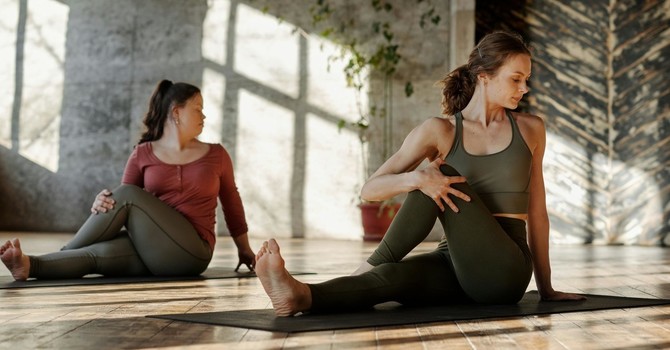
As a Bellevue Chiropractor, we deal with all sorts of patients with all sorts of complaints and personal fitness goals. Not always, but often when a patient is suffering from back or neck pain and there’s no apparent injury or immediate cause, the issue is linked to how that patient sleeps. Your back and spine are delicate and if you sleep in strained position for a long enough time, you could develop serious pain. At Summit Sport & Spine, we love educating our patients on various sleeping positions that work best for their particular situation. For those who are curious as to the ones we recommend, here are our five favorites:
-
On Your Back, Arms at Your Sides
- This is known to be the healthiest sleeping position because it allows your head, neck, and spine to all be in a neutral position. Your back remains straight, thus reducing pressure on your disks which helps prevent pain. Bonus, it may help with reducing acid reflux and improving your digestion! In some cases, this sleeping position can lead to sleep apnea and snoring for those who are prone to either. All in all, this still remains to be your back’s favorite sleeping position.
- Pro Tip: If you are a back sleeper (or would like to try to be), sneaking a pillow underneath your knees helps keep a natural curve and can also help alleviate those lower back pains!
- This is known to be the healthiest sleeping position because it allows your head, neck, and spine to all be in a neutral position. Your back remains straight, thus reducing pressure on your disks which helps prevent pain. Bonus, it may help with reducing acid reflux and improving your digestion! In some cases, this sleeping position can lead to sleep apnea and snoring for those who are prone to either. All in all, this still remains to be your back’s favorite sleeping position.
-
On Your Back, Arms Above Your Head, AKA the Starfish
- Sleeping on your back is always best for your back, but depending on different comfort preferences, you may do different things with your arms, which is totally fine. Placing your arms above your head can further reduce pressure on your disks, which may or may not result in more comfort, depending on your body. Additionally, having your arms above your head can also put pressure on your shoulders and neck, which could result in problems.
- Pro Tip: If this is your favorite sleeping position, try it without using a pillow. This will allow your spine and neck to remain in a more neutral position with your arms above your head.
- Sleeping on your back is always best for your back, but depending on different comfort preferences, you may do different things with your arms, which is totally fine. Placing your arms above your head can further reduce pressure on your disks, which may or may not result in more comfort, depending on your body. Additionally, having your arms above your head can also put pressure on your shoulders and neck, which could result in problems.
-
On Your Side with Arms at Your side
- This is another position that your back favors since your spine is straight and supported in it’s natural curve. The advantage of sleeping on your side is that sleep apnea and snoring are both greatly reduced, as is back and neck pain. On the other hand, this position also requires that one leg be supported by another which may result in hip pain in the future.
- Pro Tip: If you feel most comfortable sleeping this way, try placing a pillow between your legs at the knee. This will keep your hips more regularly aligned while on your side, which may help reduce pain. Also, if you are comfortable sleeping on either side, we recommend the left side over the right, since it’s more conducive to better digestion, circulation and may also relieve heartburn symptoms.
- This is another position that your back favors since your spine is straight and supported in it’s natural curve. The advantage of sleeping on your side is that sleep apnea and snoring are both greatly reduced, as is back and neck pain. On the other hand, this position also requires that one leg be supported by another which may result in hip pain in the future.
-
On your Side With Your Arms in Front of You AKA the Yearner
- The “Yearner” is another position that supports the spine nicely and can help relieve back and neck pain. It’s also known to help you sleep longer, as it’s one of the more comfortable positions. Those who sleep in the yearner position are less likely to wake up during the night (bonus!). But beware, with your arms in front of you, there may be reduced blood flow and circulation, which could result in pain or even nerve damage in your arms and shoulders.
- Pro Tip: This position is good for those who are worried about hip pain from sleeping on their side as your legs receive less of your overall body weight. If you’re worried about arm and shoulder pain, it’s recommended to switch back to position #3 with your arms at your side, which is great for circulation.
- The “Yearner” is another position that supports the spine nicely and can help relieve back and neck pain. It’s also known to help you sleep longer, as it’s one of the more comfortable positions. Those who sleep in the yearner position are less likely to wake up during the night (bonus!). But beware, with your arms in front of you, there may be reduced blood flow and circulation, which could result in pain or even nerve damage in your arms and shoulders.
-
On your Side, Curled Up, Aka Fetal Position
- If you’re not careful the fetal position can cause serious strain on your neck and back, so we do not typically recommend this position. Nevertheless, it is better than sleeping on your stomach and is very helpful for people dealing with acid reflux.
- Pro Tip: If you have to sleep in the fetal position make sure that you have a very firm pillow to keep your neck and back as aligned as possible. We also recommended that you alternate sides throughout the night.
- If you’re not careful the fetal position can cause serious strain on your neck and back, so we do not typically recommend this position. Nevertheless, it is better than sleeping on your stomach and is very helpful for people dealing with acid reflux.
BONUS TIP!
If you can avoid it by any means, do not sleep on your stomach! There is not enough support for your neck and spine in this sleeping position and can lead to digestive problems and lower back pain. The one positive aspect of stomach sleeping is that it can help with snoring… but other than that, we strongly advise against it. Protect that spine and try one of the other recommended positions mentioned above!
Ok, sure – your back may not have a ‘favorite’ sleeping position, but these are the 5 that are known to be best for your back in the long run. Although each position has their own respective drawbacks, moderation is always key – even with rotating sleeping positions! Try experimenting with different positions and judge your overall level of comfort and how well you sleep. Everybody is different, and certain sleeping positions just may not work for you. But it’s important know, and if you are experiencing pain or discomfort, it’s worth it to try and make the transition.
Of course, the experts at Summit Sport and Spine are always here ready and waiting to assist you with any of your back and body issues. We have the depth of services guaranteed to suit any of your needs and keep your body in tip top shape.



